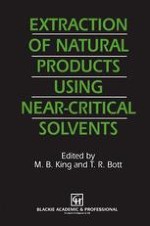
1993 | OriginalPaper | Buchkapitel
Introduction
verfasst von : M. B. King, T. R. Bott
Erschienen in: Extraction of Natural Products Using Near-Critical Solvents
Verlag: Springer Netherlands
Enthalten in: Professional Book Archive
Aktivieren Sie unsere intelligente Suche, um passende Fachinhalte oder Patente zu finden.
Wählen Sie Textabschnitte aus um mit Künstlicher Intelligenz passenden Patente zu finden. powered by
Markieren Sie Textabschnitte, um KI-gestützt weitere passende Inhalte zu finden. powered by
If the pressure is raised sufficiently, many substances which are gaseous at ambient pressure either liquefy or begin to behave like liquids in that they exert appreciable solvent power, even for solutes of low volatility. For example, at temperatures up to 31.06°C (the critical temperature) carbon dioxide can be liquefied by raising the pressure (Figure 2.1) and this liquid can be used to dissolve natural oils and quite a wide range of non-polar or slightly polar materials. Many of these are natural products and several commercial processes are based on this solubility behaviour. For example liquid CO2 has been used commercially as a solvent for obtaining hop extracts since 1980 (chapter 4). Liquid propane has also been used for extracting natural products: at one time there were about five commercial plants in use for extracting natural oils by the propane-based ‘Solexol’ process. (see appendix to this chapter). Propane has the disadvantage of being a fire-hazard, but it is a more powerful solvent than carbon dioxide and the pressures required when using it as a solvent are usually lower. Although not an example of the extraction of a natural product (the natural products considered in this book are of recent vegetable origin), it is relevant to remember the existence of the propane-based process for de-asphalting petroleum. This has been widely used since the 1930s.